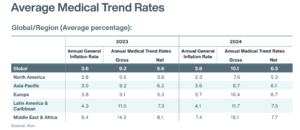Medical plan costs around the globe are set to increase at a faster rate in 2024 than 2023, with the UK set to have one of the highest rates of increase in Europe, according to Aon’s 2024 Global Medical Trend Rates Report.
Aon forecasted the global average medical trend rate for 2024 to be 10.1%, up from 9.2% in 2023 and the highest rate of increase since 2015.
But the UK is set to have its medical plan costs increase by 15% in 2024 – which puts it in the same category as countries like Mauritius, the Ivory Coast, Lithuania, Malaysia, Ecuador and Mongolia.
It also places it at the top of the G-7 countries, which includes the US, Canada, Germany, France, Italy and Japan. The next highest in the G-7 is Germany with a rate of 10.5%.
The trend rate represents the percentage increases in medical plan costs per employee – both insured and self-insured.
The report was based on insights from 113 Aon offices that broker, administer or advise on employer-sponsored medical plans in each of the countries covered.
The findings, released last week, reflect the medical trend expectations of Aon professionals based on their interactions with clients and carriers represented in the portfolio of the firm’s medical plan business in each location.
The report divides the globe into several different regions.

Europe
Europe’s projected trend for 2024 is 10.4% which is up from 9.1% in 2023 and nearly double its 5.6% rise in 2022.
Although the UK’s rate is almost 50% higher than the overall average global rate, there are several countries in Europe with higher rates. That includes Ukraine (19.3%) but not Russia (10.5%) who are currently at war.
Other countries with higher rates include Turkey, Hungary, Romania, Bulgaria, Latvia and Estonia. The European country with the lowest rate is Luxembourg with 2.5%.
“Europe’s rise, making it the third highest region globally, is expected to result in unprecedented increases on employer-sponsored medical plans, as it surpasses the double-digit barrier,” Aon said.
North America
The United States, which is believed to have the highest medical costs in the world, is likely to retain that position, as it will have a higher rate of increase than second-placed Hong Kong.
The medical trend rate in the US is expected to increase from 6.5% this year to 8% in 2024.
Canada recorded a rate of 5%.
Asia-Pacific
Outside of North America (the US and Canada) the region with the lowest rate of increase for 2024 is Asia-Pacific, where the report forecasted the average medical trend rate for 2024 to be 9.7%. But that rate was up from 9.2% in 2023 and was the highest rate since 2015.
The rate of increase for Asia-Pacific is below the overall global rate, despite both rates standing at 9.2% for 2023.
There is some good news for Hong Kong, which has the second highest medical plan costs in the world, as it is set to increase at a rate well below the global and Asia Pacific average.
For Hong Kong, the report forecasted the average medical trend rate for 2024 to be 7.5%, up from 7.0% in 2023.
But the country with the lowest rate of increase in Asia-Pacific was Japan, with a rate of 0.4% for 2024. The highest rate for the region was Kazakhstan at 30%.
But Kazakhstan compared well against Turkey, where the expected medical trend rate for 2024 is 90% – the highest rate in Europe.
Latin America and the Caribbean
Over in Latin America and the Caribbean (LAC), Japan’s low rate paled in comparison with Grenada, which is expected to have a rate of 0.0% for 2024 – the lowest in the world.
And Argentina is expected to have a higher rate than Turkey with 98%.
Venezuela, still experiencing extremely high rates of inflation, does not have an estimated rate.
“For Lebanon, Pakistan, Sierra Leone, Venezuela and Zimbabwe, we are not reporting 2024 medical trend rates due to a prevailing hyperinflation environment,” Aon said.
“We have also excluded those countries, alongside Argentina and Ukraine, from regional and global averages.”
LAC was the region with the second highest overall rate of increase at 11.7%, virtually unchanged from 11.6% in 2023.
Middle East and Africa
But the region with the highest expected medical trend rate for 2024 was the Middle East and Africa, (MEA) with a rate of 15.1%. That is up from 14.5% a year ago.
The country with the lowest rate in that region was expected to be Jordan with a rate of 5%.
The country with the highest rate was expected to be Ghana with 35%.
“Knowing the estimated costs in advance helps organisations make better decisions to address projected price inflation, explore technology advances in the medical field, plan usage patterns and cost shifting from social programmes,” Aon said.
Top three medical conditions
The top three medical conditions driving medical plan costs across the globe are e: cardiovascular, cancer and tumour growth, and high blood pressure and hypertension.
For Asia, its slightly different, as the third medical condition is gastrointestinal and digestive issues.
Meanwhile, wellness initiatives, plan design changes, cost containment, access and delivery restrictions, and flexible benefit plans are the top five mitigation initiatives expected for employers to undertake to prevent medical cost escalation and promote a healthy workforce.
In addition, 32% of employers share the medical claims costs by offering restrictive employee medical plans for example co-insurance, deductibles and limits or premium co-funding, while 22% are exploring sharing these costs with their employees.






